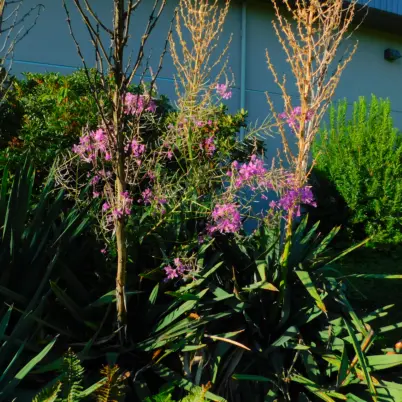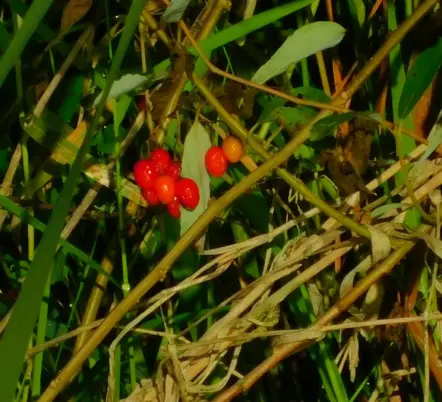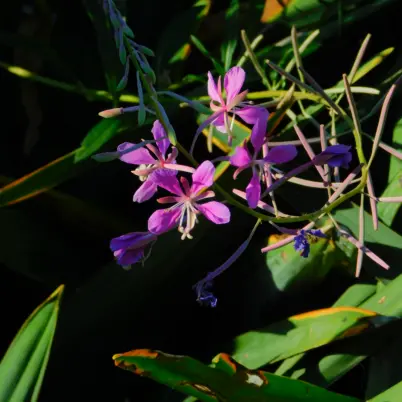Colors of Fall: Two Jealous Beauties at CPTC
Marcia Wilson


Growing in thick patches around Building 11 are two gorgeous and very incompatible wildflowers. They wear CPTC’s colors, but could not be more different from each other. One is a toxic vine imported for questionable treatments in the days before standardized medicines. It causes loss of soil and degrades native streambeds. The other is its opposite: An iconic weed symbolizing the Northwest and a beloved ingredient for some hard to find delicacies. It prevents erosion and property damage.
Bittersweet Nightshade: Lovely, Destructive, and Deadly

Solanum dulcamara is a toxic plant, which all of Dr. Faust’s students must learn to identify in the field. It is related to many safe foods, like tomatoes, potatoes, peppers and tomatillos. As a wetlands vine it grows so aggressively that it causes salmon streams to suffer in urban areas. Plots of bittersweet nightshade will strangle out the native streambank-stabilizing trees and shrubs such as the hazelnut, red osier dogwood, and red alder. The nightshade is not cold hardy and promptly dies each fall as the seasons cool. This leaves exposed swaths of bank unprotected. Stormwater and seasonal floods then will remove large amounts of soil and silt up the beds.
The “dolcamara” translates to “sweet, bitter.” In the riskier past, humans used it to treat specific conditions, and when putting the stems in the mouth the flavor it was described as being bitter, then sweet. This was a dangerous practice because the toxic alkaloids were not reliable in strength from plant to plant, or even in the same plot. Poisonings were so common that the vine was given a long string of alarming names: poisonberry, devil’s cherry, Wolfgrape, Devil’s Apple, and Snakeberry. While related to deadly nightshade, solanum dulcamara is not the same plant as its cousin, atropa belladonna.
Admire the Beauty–then Pull it Out!

Animals do not commonly spread this bad-tasting, poison plant. Unfortunately, hungry birds delight in the juicy red berries and gulp down clusters of these tiny tomato-like fruits. This spreads their seeds another year. The best time to remove the vine is any time, but the bright colors of flower and fruit make it easier to find now.
Fireweed: The Fiery Flag of Fall Foretold
“When fireweed turns to cotton, summer will soon be forgotten.”
–Alaskan proverb, origin unknown
Chamerion angustifolium is native to North America and Europe. Here it is commonly called fireweed and in Europe, rosebay willowherb.
Rosebay refers directly to its long, narrow leaves like the bay leaf, and the rosy color of the blossoms. Unlike Bittersweet Nightshade, this plant loves the sun.
It is a “pioneer” herb, quick to take advantage of a landscape left bare, and it doesn’t matter how it happened. Chamerion angustifolium will emerge in the wake of oil spills, wildfires, floods, and landslides. It was one of the first plants to return to Mt. Saint Helens after the 1980 eruption. During WWII, it bloomed up with such enthusiasm in the wake of the London Blitz that the locals called it bombweed. They still see it as a symbol of hope and renewal in the wake of destruction and despair.
Unlike the noxious bittersweet nightshade, Fireweed is palatable to humans, herbivores, insects, and birds. This food value adds to its usefulness in reclaiming lands impacted by disasters, both man-made and natural. Not only does it protect the land, it nourishes too.
In Russia, a black, caffeine-free tea is brewed from roasted and fermented leaves. It is labeled Ivan Chai, Russian Tea, or Koporsky Tea because of the large fireweed fields of Koporsky. Its marketing and export goes back since at least the 12th century. At one time it was one of Russia’s most popular exports.
A Sweet Note
Fireweed blossoms are popular ingredients in jams, jellies, and syrups for warm or cold drinks, dessert toppings, and candy. Most famously, the Puget Sounders see fireweed on the shelf as a jar of honey. This honey is a regional treat as the yields are wildly erratic and unpredictable. The flavor is light and clean with a golden tint. This adds to its reputation as rare and treasured, but the color can be occasionally a startling green. The locals will defend this green honey quite happily, but not enough to encourage its introduction into the larger market. Far better, they feel, to keep this treat to themselves.